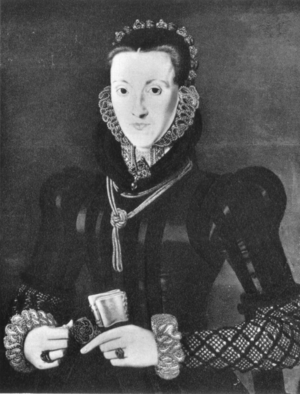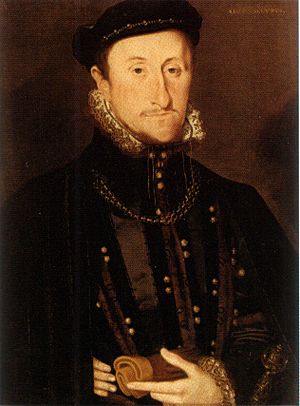Agnes Keith, Countess of Moray facts for kids
Quick facts for kids
Lady Agnes Keith
|
|
|---|---|
| Countess of Mar Countess of Moray Countess of Argyll |
|

Agnes Keith by Hans Eworth, 1562; this is a detail from her wedding portrait
|
|
| Born | c.1540 Dunnottar Castle, Aberdeenshire, Scotland |
| Died | 16 July 1588 Edinburgh, Scotland |
| Buried | St. Giles Cathedral, Edinburgh, Scotland |
| Noble family | Keith |
| Spouse(s) |
|
| Issue | Elizabeth Stewart, 2nd Countess of Moray Annabel Stewart Lady Margaret Stewart Hon. Colin Campbell of Lundie Lady Jane Campbell Archibald Campbell, 7th Earl of Argyll |
| Father | William Keith, 4th Earl Marischal |
| Mother | Margaret Keith |
Agnes Keith, Countess of Moray (born around 1540 – died 16 July 1588) was an important Scottish noblewoman. She was married to James Stewart, 1st Earl of Moray, who was the regent (a ruler who governs for a young king or queen) of Scotland. James was also the half-brother of Mary, Queen of Scots. This made Agnes the queen's sister-in-law.
When her husband became regent in 1567, Agnes became the most powerful woman in Scotland. This lasted until her husband was killed in 1570. Later, Agnes married Sir Colin Campbell. When he became the 6th Earl of Argyll in 1573, Agnes was known as the Countess of Argyll. During this marriage, Agnes was involved in a big disagreement over some of Queen Mary's valuable jewels.
Agnes was also sometimes called "Annabel" or "Annas". Some historians now use "Annas Keith" because that's how her name was often spelled back then.
Contents
Agnes's Family and Early Life

Lady Agnes Keith was born around 1540 at Dunnottar Castle in Aberdeenshire, Scotland. She was the oldest daughter of William Keith, 4th Earl Marischal, and Margaret Keith. Her father was a member of Queen Mary's special council of advisors. He also fought in the Battle of Pinkie in 1548.
Agnes had two brothers and six younger sisters. Her aunt, Elizabeth Keith, Countess of Huntly, was married to George Gordon, 4th Earl of Huntly. He led a rebellion against Mary, Queen of Scots, in 1562. Agnes's first cousin, Jean Gordon, Countess of Bothwell, later married James Hepburn, Earl of Bothwell. He became Queen Mary's third husband.
First Marriage to the Earl of Moray

On 8 February 1562, Agnes married James Stewart. The wedding took place at St. Giles Cathedral in Edinburgh or at Holyrood. James was the half-brother and main advisor to Mary, Queen of Scots. He had just been given the title Earl of Mar the day before.
The wedding was very grand, with many important people attending. John Knox, a famous preacher, gave the sermon. After the wedding, there were three days of parties and feasts at Holyrood Palace. There were also fireworks and a tournament. People said the feasts had many delicious foods, including wild venison. This impressed Queen Mary's uncle, the Marquis of Elbeuf.
Queen Mary liked Agnes very much and saw her as a close family member. Agnes was described as having "genuine intelligence and spirit". One historian called her "clever, eager, and strong-willed". Queen Mary even planned to be with Agnes when her first child was born. Sadly, this child was a son who died soon after birth.
Agnes and James had three daughters:
- Elizabeth Stewart, 2nd Countess of Moray (born late 1565 – died 18 November 1591). She married James Stewart of Doune and had five children.
- Lady Annabell Stewart (born 1568/1569 – died 1570). She was born in Stirling.
- Lady Margaret Stewart (born early 1570 – died before 1586). She married Francis Hay, 9th Earl of Errol, but they had no children.
The queen had secretly given her half-brother the title of Earl of Moray in January 1562. This title usually belonged to George Gordon, 4th Earl of Huntly, who was married to Agnes's aunt. James later gave up the Earl of Mar title but kept the Earl of Moray title. This made the Earl of Huntly angry, and he started a rebellion against the queen. Huntly's rebellion was defeated by James's soldiers in October 1562.
The Chaseabout Raid
The Earl of Moray and his half-sister, Queen Mary, became enemies after Mary married Henry Stewart, Lord Darnley in July 1565. Moray strongly disagreed with this marriage. Moray was declared an outlaw after his rebellion, known as the "Chaseabout Raid". He went to England.
Agnes was pregnant and planned to join him. However, her ship was captured, and she couldn't travel. She stayed at their home in St. Andrew's Priory. Later in 1565, she gave birth to her daughter, Elizabeth. After recovering, she continued to manage their family's lands very well. Her husband returned to Scotland in March 1566 and was forgiven by the queen.
In August 1566, after the birth of Prince James (who would become King James VI of Scotland), Agnes was one of the ladies Queen Mary spent the most time with. In February 1567, Agnes had a miscarriage. This gave her husband an excuse to leave Edinburgh quickly. So, he was away when Lord Darnley was murdered.
Scotland's Most Powerful Woman
Queen Mary was removed from power by a group of lords at the battle of Carberry Hill. Mary was taken to Lochleven Castle. Even though the lords would not send Moray's letters to Mary, Agnes stayed with the Queen at Lochleven in July 1567. The English ambassador noted there was "great sorrow" when they met and when they parted. Soon after, on 24 July 1567, Mary gave up her crown.
Moray was declared Regent of Scotland for the young King James VI on 22 August 1567. While her husband was regent, Agnes, Countess of Moray, was the most powerful woman in Scotland. She was a very smart and strong politician. Many people were afraid to make her angry. In May 1568, before the Battle of Langside, she told her frightened cousin, George Gordon, 5th Earl of Huntly, "you have made me angry." Huntly had said he would support Mary instead of Regent Moray.
Moray was killed in Linlithgow in January 1570. He was shot by James Hamilton of Bothwellhaugh, who supported Queen Mary. Agnes was pregnant when her husband was murdered. She gave birth to their daughter, Margaret, shortly after. For two years, she managed the family's lands and fought legal battles to get money for her husband's time as regent.
In April 1570, Agnes's secretary visited Lochleven Castle. He checked on Agnes's daughter, Annabell, who was being cared for by her grandmother. Annabell was described as "merry and very lively." However, some months later, Annabell died.
Second Marriage and Queen Mary's Jewels
Between January 1571 and February 1572, Agnes married Sir Colin Campbell. He was the son of Archibald Campbell, 4th Earl of Argyll. They had three more children:
- Hon. Colin Campbell of Lundie (died before 1619). He married Maria Campbell and had children.
- Lady Jane Campbell. She married Sir Donald Campbell.
- Archibald Campbell, 7th Earl of Argyll (1575–1638). He married twice and had children.
Agnes was removed from the Church on 25 April 1573. This was because she did not follow her husband's lead in church matters. People said that Sir Colin was "much advised by Agnes" and "overmuch led by his wife." Agnes was seen as a very smart and strong politician.
When her brother-in-law, Archibald Campbell, 5th Earl of Argyll, died in September 1573, Agnes's husband, Sir Colin, became the 6th Earl. From then on, Agnes was called the Countess of Argyll.
Queen Mary's Jewels
After Queen Mary was taken to Lochleven Castle in 1567, her valuable jewels were given to the Earl of Moray. Moray sold some of these crown jewels to Elizabeth I of England and used others to help pay for the civil war. Agnes ended up with some of these jewels.
After Moray was killed, Mary, Queen of Scots, wrote to Agnes in March 1570. Mary wanted her jewels sent to her in England. This included a special piece with diamonds and rubies called the "H," also known as the ""Great Harry"." This diamond was a gift to Mary from King Henry II of France when she first married.
However, the new Regent, Lennox, also asked for the jewels. Agnes faced a difficult choice: give the jewels to Mary or to the Scottish government. Agnes decided to keep the jewels.
Agnes wanted to keep these valuable jewels. This caused a big disagreement between her second husband and the Regent Morton. Morton demanded the jewels back, saying they belonged to the Scottish Crown. He threatened to arrest Agnes and her husband if they didn't return them. Agnes argued that she was keeping the jewels as a promise for the money her first husband, the Earl of Moray, was owed for his time as regent.
When Agnes and her husband did not hand over the jewels, they were declared rebels on 3 February 1574. Agnes asked the Scottish Parliament for help. She also wrote several clear letters to Queen Elizabeth, asking her to step in so Agnes could keep the jewels.
The long argument and legal battle over the jewels ended on 5 March 1575. The Earl of Argyll and Agnes finally gave the jewels to Regent Morton. The Earl of Argyll later played a part in Regent Morton losing his power in 1578.
Later Life and Death
In August 1584, a messenger from Mary, Queen of Scots, visited Scotland. He wrote to Mary that Agnes Keith was happy to hear his news. The messenger liked Agnes because she spoke of her love for Mary. However, Agnes did not have much influence with the Scottish government at that time.
Agnes died on 16 July 1588 in Edinburgh. She was buried next to her first husband in St Giles' Cathedral. Her tomb was carved by John Roytell and Murdoch Walker.
Agnes Keith was cared for by doctors and surgeons during her illness in Edinburgh. Her will, which listed gifts and debts, was approved on 9 August 1591.
Depiction in Art
The famous Flemish artist Hans Eworth painted portraits of Agnes and her first husband, the Earl of Moray, in 1562. These paintings were made to celebrate their marriage.
Images for kids
-
Dunnottar Castle, the birthplace of Agnes Keith
-
Portrait of James Stewart, Earl of Moray, the first husband of Agnes Keith. It was painted by Hans Eworth in 1562
See Also



